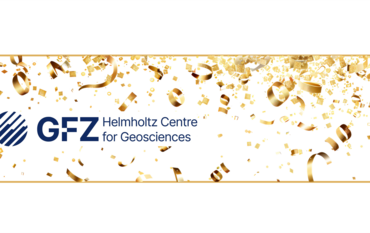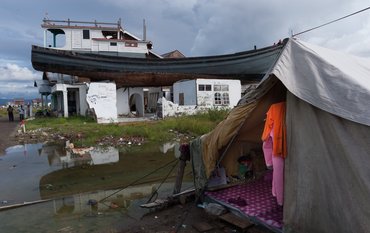Study in the Mackenzie Delta in Canada shows large emissions of geological methane
The thawing permafrost soils in the Arctic regions might contribute to the greenhouse effect in two ways: On the one hand rising temperatures lead to higher microbial methane production close to the surface. On the other hand deeper thawing opens new pathways for old, geologic methane. This is shown in a study in the Mackenzie Delta (Canada), conducted by scientists from the German Research Centre for Geosciences GFZ, the Alfred Wegener Institute, Helmholtz Centre for Polar and Marine Research (AWI) and partners in the US. The study is published in the journal Scientific Reports.
Arctic permafrost acts like a gigantic cap of frozen material over mineral resources and fossil fuels. Scientists apprehend that thawing permafrost could lead to rising methane emissions. “We wanted to find out how much methane is released on a regional scale and were looking for spatial patterns in gas emissions”, says lead author Katrin Kohnert from GFZ´s section for Remote Sensing. In order to do so a team led by GFZ scientist Torsten Sachs performed a study in a 10,000 square kilometre area in Northern Canada. Using the research aircraft Polar 5 of AWI the scientists conducted airborne measurements of atmospheric gas concentrations and meteorological variables during two extensive flight campaigns in the summers of 2012 and 2013.
The result was a high-resolution (100 m x 100 m) methane flux map of the Mackenzie Delta. “We found strong emissions solely where the permafrost is discontinuous, that is where the landscape contains areas that are thawed permanently”, says Katrin Kohnert. “We think that the methane comes predominantly from deeper geologic sources and not from recent microbial activity close to the surface.” Even though the hotspots only occur on about 1 percent of the area, they contribute 17 percent to the annual methane emission estimate of the study area.
The conclusion of the authors: The warming climate triggers not only the natural production of biogenic methane, it can also lead to stronger emissions of fossil gas. This could contribute significantly to the permafrost-carbon-climate feedback. Kohnert: “Therefore permafrost areas vulnerable to thawing warrant much more attention.”
19.07.2017
Original study: Kohnert, K., Serafimovich, A., Metzger, S., Hartmann, J., Sachs, T., 2017. Strong geologic methane emissions from discontinous terrestrial permafrost in the Mackenzie Delta, Canada. Nature Scientific Reports 7, 5828. DOI: 10.1038/s41598-017-05783-2
---
Figures in a printable resolution may be found here:
Figure 1) Landscape in the Mackenzie Delta (Canada; photo: K. Kohnert, GFZ). https://media.gfz-potsdam.de/gfz/wv/05_Medien_Kommunikation/Mackenzie/Fig.3.JPG
Fig. 2) Reflection und shadow of Polar 5 during the flight over Mackenzie Delta. Photograph taken by the on-board camera of the aircraft (photo: GFZ) https://media.gfz-potsdam.de/gfz/wv/05_Medien_Kommunikation/Mackenzie/Fig.4.jpg
Fig. 3) View out of the window of Polar 5 during the flight campaign over the Mackenzie Delta (photo: T. Sachs, GFZ). https://media.gfz-potsdam.de/gfz/wv/05_Medien_Kommunikation/Mackenzie/Fig.1.JPG
Fig. 4) Map of the methane fluxes in the northern part of the study area (fig.: B. Juhls, GFZ). https://media.gfz-potsdam.de/gfz/wv/05_Medien_Kommunikation/Mackenzie/Fig.5.png






![[Translate to English:] Fire in a forest, smoke rising, aerial view from above](/fileadmin/_processed_/8/3/csm_2025_01_06_AdobeStock_415831729_5a0e6d50d3.jpeg)









![[Translate to English:] [Translate to English:] Abror Gafurov von dem Schriftzug "Welcome to Azerbaijan" und den UN und COP Logos](/fileadmin/_processed_/2/5/csm_2024_11_Baku_COP29_Abror_Gafurov_1042faec82.jpeg)


![[Translate to English:] Martin Herold standing in front of the library on the Telegrafenberg](/fileadmin/_processed_/c/d/csm_Martin_Herold_d385ee4dd9.jpeg)
![[Translate to English:] Many people are listening to a presentation in the GFZ lecture hall.](/fileadmin/_processed_/c/a/csm_1_Bild1_hell_b9c0e9f5ed.jpeg)






![[Translate to English:] Both scientists sitting on stools in front of a wall of books in the Telegrafenberg library](/fileadmin/_processed_/6/6/csm_Buiter_Castell_DORA_4_e87cb1ea18.jpeg)
![[Translate to English:] Gruppenbild mit 4 Personen](/fileadmin/_processed_/8/d/csm_20241017_GFZ-Emmerman-Medal-005_web_reinhardtundsommer_21a414fa4a.jpeg)






![[Translate to English:] Ice landscape with five red tents](/fileadmin/_processed_/8/9/csm_Zeltlager_auf_dem_Eis_Urheberin_Jenine_McCutcheon_5ced2d523b.jpeg)